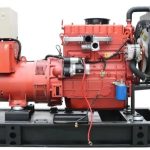Introduction
Diesel generators play a crucial role in providing reliable backup power in a wide range of applications. One common challenge faced by diesel generators is the handling of transient loads. Transient loads refer to sudden changes in power demand that can significantly impact the performance and efficiency of diesel generators. In this article, we will delve into the intricacies of transient loads and explore strategies to optimize diesel generators for such scenarios.
Understanding Transient Loads
To comprehend the impact of transient loads on diesel generators, it is essential to first understand what transient loads are and how they differ from steady-state loads. In simple terms, transient loads are sudden and short-lived spikes in power demand that deviate from the normal operating conditions of a generator. These spikes can be caused by various factors such as starting motors, switching on heavy equipment, or sudden changes in load requirements.
Unlike steady-state loads that remain relatively constant over time, transient loads introduce rapid changes in power demand, leading to fluctuations in generator output. These fluctuations can strain the generator's components, affect its performance, and potentially lead to inefficiencies or even failure if not managed properly.
Challenges Posed by Transient Loads
Transient loads present several challenges for diesel generators, including:
1. Mechanical Stress: Sudden changes in load can subject the generator's mechanical components, such as the engine and alternator, to increased stress. This can accelerate wear and tear, reduce component lifespan, and result in unplanned maintenance or downtime.

2. Voltage and Frequency Instability: Transient loads can cause fluctuations in voltage and frequency output, affecting the quality of power delivered to connected loads. Voltage and frequency deviations beyond permissible limits can damage sensitive equipment and disrupt operations.
3. Fuel Efficiency: Diesel generators are designed to operate most efficiently at steady-state loads. Transient loads can impact fuel efficiency as the generator adjusts its output to meet the sudden increase in demand, leading to suboptimal performance and increased fuel consumption.
4. Emissions and Environmental Impact: Inefficient operation due to transient loads can result in higher emissions of pollutants such as carbon monoxide, nitrogen oxides, and particulate matter. This not only harms the environment but also raises compliance concerns with regulatory standards.
Optimization Strategies for Diesel Generators
To address the challenges posed by transient loads and optimize diesel generators for such scenarios, several strategies can be employed:
1. Proper Sizing: One of the fundamental steps in optimizing a diesel generator for transient loads is ensuring it is adequately sized to handle peak power demands. Undersized generators may struggle to cope with sudden load spikes, leading to voltage dips, frequency deviations, and potential damage to the system. On the other hand, oversized generators can be inefficient and costly to operate at lower loads. Conducting a thorough load analysis and consulting with experts can help determine the right generator size for the application.
2. Fast Response Time: Diesel generators equipped with advanced control systems and responsive governors can quickly adjust their output to accommodate transient loads. Fast response times are crucial in maintaining voltage and frequency stability during sudden load changes. Consider investing in generators with features like electronic governors, load-sharing capabilities, and automatic voltage regulators for enhanced responsiveness.
3. 500KW Diesel Generator For Sale : Regular load bank testing is essential to assess the performance of a diesel generator under varying load conditions, including transient loads. By subjecting the generator to simulated load changes, operators can identify potential issues, validate the system's response time, and fine-tune its settings for optimal performance. Load bank testing also helps prevent wet stacking, a common problem in diesel generators operating at light loads for extended periods.
4. Oversizing Components: In addition to sizing the generator appropriately, oversizing certain components can improve the system's resilience to transient loads. Upgrading critical components such as the alternator, engine, cooling system, and fuel system can enhance the generator's capacity to handle sudden power surges without compromising reliability. Consult with manufacturers or specialists to determine the most suitable components for your specific transient load requirements.
5. Energy Storage Systems: Integrating energy storage systems, such as batteries or capacitors, with diesel generators can provide additional support during transient load events. These systems can...
